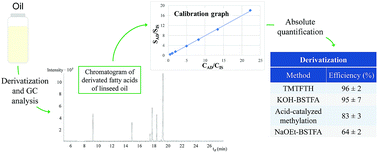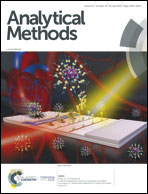Comparison of derivatization methods for the quantitative gas chromatographic analysis of oils†
Abstract
The determination of fatty acid composition using quantitative gas chromatographic (GC) analysis is a common method of characterizing fats and oils. A wide variety of derivatization methods have been developed to enable the GC analysis of non-volatile oil components. However, there has been no systematic comparison of these derivatization procedures in truly quantitative terms, i.e. with absolute amounts of fatty acids, not just ratios. In this paper, for the first time, a comprehensive quantitative comparison of four derivatization methods is presented: (1) m-(trifluoromethyl)phenyltrimethylammonium hydroxide (TMTFTH) methylation, (2) two-step derivatization with sodium ethoxide (NaOEt) and N,O-bis(trimethylsilyl)trifluoroacetamide (BSTFA), (3) two-step derivatization with KOH and BSTFA and (4) acid-catalyzed methylation (ACM). The comparison of the results obtained with both a mass spectrometric (MS) detector and a flame ionization detector (FID) is mainly based on derivatization efficiency (absolute quantification) and intermediate precision (within-lab reproducibility) over several weeks. The overall results indicate that out of the four examined methods the TMTFTH derivatization was the least work-intensive and the most accurate – both in terms of reproducibility and derivatization efficiency.

- This article is part of the themed collection: Analytical Methods Recent HOT articles


 Please wait while we load your content...
Please wait while we load your content...